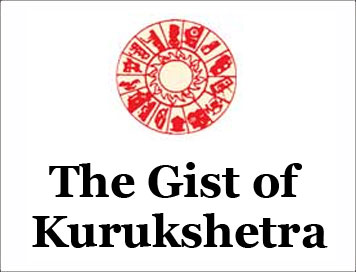(HOT) UPSC Current Affairs 2025 PDF
NEW! The Gist (NOV-2025) | E-BOOKS
(GIST OF KURUKSHETRA) GRAMODAY 2.0: FROM SKILLS TO SELF-RELIANCE
(GIST OF KURUKSHETRA) GRAMODAY 2.0: FROM SKILLS TO SELF-RELIANCE
(SEPTEMBER-2025)
GRAMODAY 2.0: FROM SKILLS TO SELF-RELIANCE
Context:
The Bio-Village 2.0 initiative, 64 of its 70 households have embraced solar power, biogas, and organic farming, reducing dependence on fossil fuels and harmful chemicals while raising monthly incomes by over Rs. 5,000. The village runs as much on skills as on sunlight, as residents operate puffed rice machines, manage solar pump sets, and nurture fisheries in community ponds. Cleaner air and richer soil are now matched by a stronger sense of economic independence. Skill development lies at the heart of this transformation. Local farmers and artisan have learned mushroom cultivation, bio-composting and other sustainable practices, creating new income streams beyond traditional farming.
Achievements:
-
64 of 70 households run on solar power and biogas.
-
Organic farming reduces chemical use, enhances soil quality.
-
Average household incomes increased by over ₹5,000/month.
-
Residents manage puffed rice machines, solar pump sets, and fisheries in community ponds.
-
Economic independence matched by environmental gains (cleaner air, healthier soil).
-
Dhudmaras, Chhattisgarh – A Solar Powered Tourism Hub
-
Located in Bastar district, recognised by the UN World Tourism Organization as one of the world’s best tourism villages.
Key features:
-
Solar pumps supply drinking water; schools and streetlights run on renewable energy.
-
Adventure tourism developed: kayaking, bamboo rafting, trekking led by trained tribal youth.
-
Artisans craft souvenirs, eco-trails highlight conservation.
-
40 Dhurwa tribal families engaged in tourism-based livelihoods.
-
Homestays promote cultural immersion and income generation.
-
Daspara thrives on agricultural sustainability.
-
Dhudmaras thrives on tourism and renewable energy.
-
Together, they prove rural India can combine tradition with modern skills and technology.
-
Gramoday 2.0 represents this vision of selfreliant, resilient, and prosperous villages.
Gramoday – From Vision to Reality
-
Gandhian Foundations: Mahatma Gandhi envisioned Gramoday to Rashtroday – strengthening villages as the foundation of national progress.
-
Rural India holds: Over 2.5 lakh Panchayats. More than 30 lakh elected representatives.
-
Philosophy of Gramoday: Focus on self-sustaining, resilient rural communities.
-
Principles: holistic well-being, social justice, and equity. Education and skill development as central pillars.
-
Role of Visionary Leaders: Nanaji Deshmukh operationalised Gramoday philosophy.
-
Principles: self-reliance, sustainability, grassroots empowerment. Influenced by Pandit Deendayal Upadhyaya’s Integral Humanism and Antyodaya (upliftment of the last person).
-
Contributions: Bhoodan Movement, Models of self-reliance, Conflict resolution approaches, His legacy continues through sustainable development models and people-centric governance, Contemporary Alignment.
-
Union Government under PM Modi has adopted Antyodaya principles, focusing on: empowering the poorest, building strong Panchayats, integrating technology with tradition.
Skills as the Key to Self-Reliance
-
Beyond Welfare and Infrastructure: Rural development is shifting from subsidy dependence to skill-driven self-reliance. Skill development ensures sustainable livelihoods and resilience.
Flagship Rural Skill Initiatives under MoRD:
-
MGNREGA: Provides 100 days employment annually, ensures safety net for SCs, STs, women.
-
Mission Antyodaya: Integrates multiple ministries for coordinated development at Panchayat level.
RSETIs – Grassroots Entrepreneurship Training
-
Run in every district with support of banks and states. Based on the RUDSETI model (Karnataka).
-
Infrastructure: classrooms, workshops, dormitories, women facilities, staff quarters.
-
Training: 30–40 short-term courses annually (1–6 weeks).
-
Focus: agriculture, manufacturing, services, construction, hospitality. Includes soft skills, financial literacy, yoga, motivational training. At least 70% trainees from BPL households. Training free; bank-recognised certification ensures credit access.
Digital India at the Village Doorstep
-
Common Service Centres (CSCs): Expanded from 83,000 (2014) to 5.5 lakh (2025)
-
Coverage: nearly 90% of India’s villages.
-
Services offered: Aadhaar updates, passports, banking, insurance, telemedicine, education, legal aid, agrisupport.
-
Operated by Village Level Entrepreneurs (VLEs) – 74,000 women among them.
-
New Digital Push (2025): Free AI training for 10 lakh individuals, prioritising VLEs.
-
Integration of Primary Agriculture Credit Societies with CSCs.
-
Reinforces inclusive digital empowerment.
Women as Rural Entrepreneurs
-
SHGs as Engines of Empowerment: Over 10 crore women in 91 lakh SHGs under DAY-NRLM. Govt. vision: 3 crore Lakhpati Didis.
Strategies:
-
Diversified livelihoods.
-
Convergence of govt. and private support.
-
Timely credit, assets, market access.
Conclusion:
India’s rural transformation under Gramoday 2.0 is not a set of fragmented efforts but a unified national mission. It merges skills with security, digitisation with dignity, and local enterprise with national growth, turning CSCs into hubs of digital empowerment, SHGs into economic units, and trained youth into catalysts for change.
CLICK HERE TO DOWNLOAD FULL PDF
CLICK HERE TO DOWNLOAD UPSC E-BOOKS
Study Material for UPSC General Studies Pre Cum Mains
Get The Gist 1 Year Subscription Online
Click Here to Download More Free Sample Material
<<Go Back To Main Page
Courtesy: Kurukshetra



